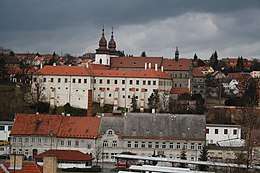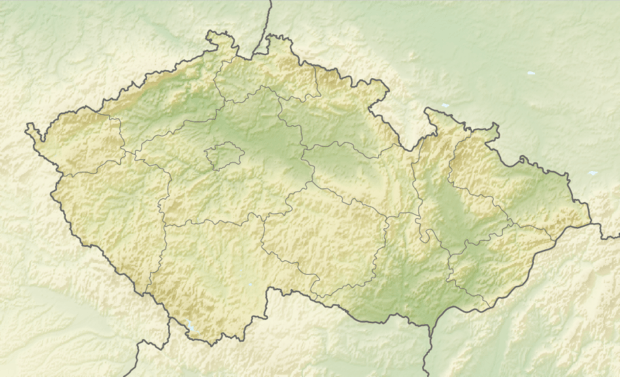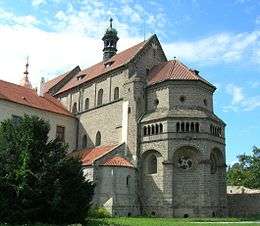St. Procopius Basilica in Třebíč
St. Procopius Basilica is a Romanesque-Gothic Christian church in Třebíč, Czech Republic. It was built on the site of the original Virgin Mary's Chapel[1] of the Benedictine monastery in 1240–1280. It became a national cultural monument in 2002 as a part of the "monastery with St. Procopius church".[2] The basilica together with the Jewish Quarter in Třebíč were inscribed as a UNESCO World Heritage Site in 2003.[3]
| UNESCO World Heritage Site | |
|---|---|
 Overview of Basilica of Saint Procopius in Třebíč | |
| Official name | St Procopius' Basilica |
| Location | Třebíč, Vysočina Region, Czech Republic |
| Part of | Jewish Quarter and St Procopius' Basilica in Třebíč |
| Criteria | Cultural: (ii), (iii) |
| Reference | 1078-003 |
| Area | 0.2301 ha (0.569 acres) |
| Coordinates | 49°13′1.03″N 15°52′25.09″E |
 Location of St. Procopius Basilica in Třebíč in Czech Republic | |
The basilica was originally dedicated to the Assumption of the Virgin Mary. Saint Procopius became the Patron saint of the basilica on the quincentenary his canonization in 1704. Jan Karel, Count of Valdštejn established a castle chapel of St. Procopius from the presbytery of the basilica.[4][5]
As of 2013, the renovated Třebíč castle is a museum adjacent to the Basilica.[6][7][8]

History
The history of the basilica is closely associated with the history of the former Benedictine monastery in Třebíč. Before the basilica was constructed there was a chapel of St. Procopius, which was built in the year 1104 and was consecrated by Heřman, Bishop of Prague. Five years later, the monastery already had its own church. This was consecrated in year 1109 by then Bishop of Prague, Jan II. In the crypt of the church Duke Litold Znojemský was buried, one of the founders of the monastery, and three years later his brother and Duke Oldřich Brněnský, the second founder of the monastery, was likewise interred.
The monastery grew rich and its influence swelled. For about half of the 13th century the monastery was rebuilt and fortified. This reconstruction was started in about the year 1240 and finished in the year 1260. The reconstruction meant the disappearance of romanesque architecture in the monastery, but allowed for the new basilica to be built. The basilica is preserved in its original style to this day.
See also
References
| Wikimedia Commons has media related to Basilica of Saint Procopius in Třebíč. |
- DOLEŽEL, František Borgiáš. Basilika sv. Prokopa v Třebíči. In Čeněk Sameš. Třebíč – město a okres. Brno : Národohospodářská propagace ČR, 1935. p. 55.
- Nařízení vlády č. 337/2002 Sb., o prohlášení a zrušení prohlášení některých kulturních památek za národní kulturní památky.
- Jewish Quarter and St Procopius' Basilica in Třebíč
- DOLEŽEL, František Borgiáš. p. 58.
- Bartušek, Antonín. Umělecké památky Třebíče. 1. vyd. Brno : Blok, 1969. p. 71.
- About the Castle: Exhibition of Vysočina Museum Třebíč at www
.zamek-trebic .cz - The Castle of Třebíč at www
.trebiczije .cz - The castle: Vysočina Museum Třebíč at www
.visittrebic .eu